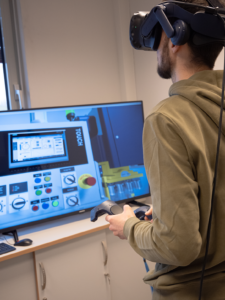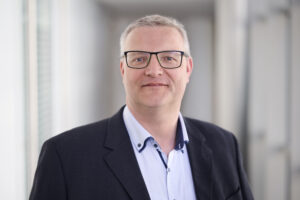Virtual reality already has a firm place in digital engineering. Now, new possibilities must be explored to optimize the value chain from planning on the digital model to the life cycle of the plant during ongoing production. This is what onoff engineering gmbh and Siemens have currently achieved in a joint project. The goal was to develop a solution that combines the use of a digital twin with virtual commissioning to enable optimal training of plant operators as well as training of service personnel in the area of maintenance and repair.
Realistic 3D environment
In this combination, the joint project represents a real premiere – and the result is convincing: Based on a special machine for forming technology with manual and automated work processes, a  very realistic 3D environment was created that fulfills all requirements for training and maintenance. The heart of the special machine is the Siemens automation system – the TIA S7-1517F controller. All processes and functionalities are controlled or regulated from here. The forming machine is operated via a Siemens touch panel with WinCC application. This enables operation by the operator via an HMI (Human Machine Interface). The forming machine is again loaded manually, which entails special requirements in terms of personal safety. This is realized via a safety-relevant light grid, which releases the forming process via two-hand operation after insertion. To simulate the sensors and actuators as well as their behavior in the forming machine, the corresponding simulation tool SIMIT from Siemens is used.
very realistic 3D environment was created that fulfills all requirements for training and maintenance. The heart of the special machine is the Siemens automation system – the TIA S7-1517F controller. All processes and functionalities are controlled or regulated from here. The forming machine is operated via a Siemens touch panel with WinCC application. This enables operation by the operator via an HMI (Human Machine Interface). The forming machine is again loaded manually, which entails special requirements in terms of personal safety. This is realized via a safety-relevant light grid, which releases the forming process via two-hand operation after insertion. To simulate the sensors and actuators as well as their behavior in the forming machine, the corresponding simulation tool SIMIT from Siemens is used.
Operating, controlling and entering with VR glasses
Virtual reality means that the planner, designer and commissioning engineer as well as the operator can operate, control and also enter the machine in a 3D environment. This requires the appropriate equipment, which has long been familiar from the gaming world: VR glasses and sensors for detecting hand movements. The 3D environment in which the human is located in his position was mapped in the current project with UNITY. Through the coupling with SIMIT, the bridge between the visual possibilities in the industrial application is created.
“Walking on the machine, albeit virtually, is extremely close to reality. This allows spatial planning in basic engineering on the digital model, virtual commissioning in coupling with the automation systems as well as training of employees to be carried out, and this even before the machine has been built,” explains Roman Pieloth, site manager Erlangen, onoff engineering gmbh.
End of the value chain not yet reached
But this is not the end of the value chain: With the digital twin and a recording of the process data, analyses of yesterday’s production can be reproduced in detail. Error analyses and optimizations can thus be implemented in a different quality.



